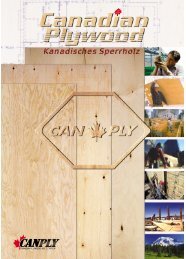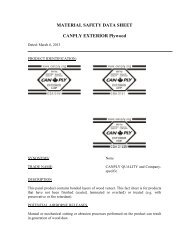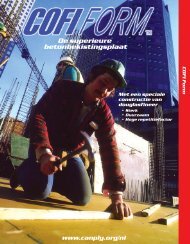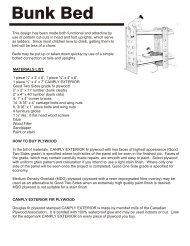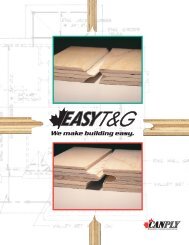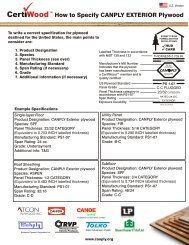Plywood Design Fundamentals - Canadian Plywood Association
Plywood Design Fundamentals - Canadian Plywood Association
Plywood Design Fundamentals - Canadian Plywood Association
Create successful ePaper yourself
Turn your PDF publications into a flip-book with our unique Google optimized e-Paper software.
2012_april revised_48945_en_design.qxd 19/04/2012 3:04 PM Page 7<br />
3.4 Dimensional Stability<br />
<strong>Plywood</strong> is subject to dimensional changes in response to<br />
fluctuations of ambient temperature and contact with liquids<br />
or vapours. Expansion in plywoods of balanced construction<br />
is slightly greater along the grain but much less across<br />
the grain than for solid wood.<br />
The dimensional change, however, is approximately the<br />
same per unit of length in both directions because of the<br />
averaging influence of cross-bands. Change in thickness<br />
for all practical purposes is identical to that of solid wood in<br />
the radial direction.<br />
Effect of Moisture<br />
<strong>Plywood</strong>’s cross-laminated construction provides superior<br />
dimensional stability in the plane of the panel. The swelling<br />
or shrinking of wood along the grain with changes in moisture<br />
content is small, being only about 1/20 to 1/40 of that<br />
across the grain. The tendency of individual veneers to swell<br />
or shrink crosswise, therefore, is greatly restricted by the relative<br />
longitudinal stability of the adjacent plies.<br />
Expansion of a plywood panel that is free to move consists<br />
of a uniform restrained swelling across the full width or<br />
length, and a less restrained swelling at the edges. Edge<br />
swelling is independent of panel size, varies with the thickness<br />
of veneers having grain perpendicular to the direction<br />
of expansion and, for the same veneer thickness, is about<br />
twice as great for face plies as for inner plies.<br />
The average coefficient of hygroscopic expansion in thickness<br />
is about 0.003 mm per millimetre of original thickness<br />
for each 1% change in moisture content.<br />
Internal uniform dimension changes in a panel decrease as<br />
the percentage of panel thickness in plies having grain perpendicular<br />
to the direction of expansion or contraction<br />
decreases. Standard plywood constructions of four or more<br />
plies are well balanced and the perpendicular ply percentage,<br />
both across the width and along the length, seldom<br />
exceeds 60%. The average coefficient of hygroscopic<br />
expansion (or contraction) for these constructions is about<br />
0.0002 mm per millimetre of length or width for each 10%<br />
change in equilibrium relative humidity; or 0.2% from ovendry<br />
to complete saturation.<br />
The approximate relationship between relative humidity (RH)<br />
and equilibrium moisture content (EMC) of plywood is:<br />
RH (%)<br />
10<br />
20<br />
30<br />
40<br />
50<br />
60<br />
70<br />
80<br />
90<br />
100<br />
EMC at 24 o C (%)<br />
2<br />
4<br />
6<br />
7<br />
9<br />
11<br />
13<br />
16<br />
20<br />
28<br />
In normal conditions of dry use, equilibrium relative humidity<br />
may vary between 40 and 80%, with corresponding moisture<br />
contents ranging from 7 to 16%. Total dimensional changes<br />
of a 1220 mm by 2440 mm panel exposed to this change in<br />
conditions may be expected to average about 1.0 mm<br />
across the width and 2.0 mm along the length.<br />
7<br />
Effect of Temperature<br />
<strong>Plywood</strong> expands on heating and contracts on cooling. The<br />
rate of thermal expansion or contraction is practically independent<br />
of the temperature range involved, but is strongly<br />
influenced by the construction of the plywood. Thermal<br />
changes cause wood to expand about 10 times as much<br />
across the grain as it does parallel. By ignoring the influence<br />
of variations in moisture content and specific gravity, the<br />
average coefficient of linear thermal expansion a can be calculated<br />
for a temperature change of 1 °C from the following<br />
formulas:<br />
For length and width: For thickness:<br />
( ) ]<br />
ap »<br />
a t » 28 x 10 -6<br />
Values of a p for various plywood constructions are presented<br />
in Figure 2.<br />
Changes in panel dimension (length, width or thickness) due<br />
to a change in temperature can be calculated as:<br />
Final dimension = Original dimension [1 + a(DT)]<br />
where a = coefficient of thermal expansion (a p or a t).<br />
DT= change in temperature (°C)<br />
Coefficient of linear thermal expansion parallel or perpendicular<br />
to face grain direction per oC (µ p x 10-6 [<br />
)<br />
16<br />
14<br />
12<br />
10<br />
8<br />
6<br />
4<br />
2<br />
36 1 -<br />
40 -<br />
1 - 0.92<br />
0 0.0 0.2 0.4 0.6 0.8 1.0 1.2<br />
t^ ( t )<br />
t^<br />
t<br />
t^<br />
t<br />
Ratio of thickness of plies perpendicular to<br />
the direction of expansion to total thickness<br />
of panel<br />
Figure 2. Coefficients of Linear Thermal Expansion<br />
for <strong>Plywood</strong> of Various Constructions<br />
certiWood Canply plywood <strong>Design</strong> <strong>Fundamentals</strong>



